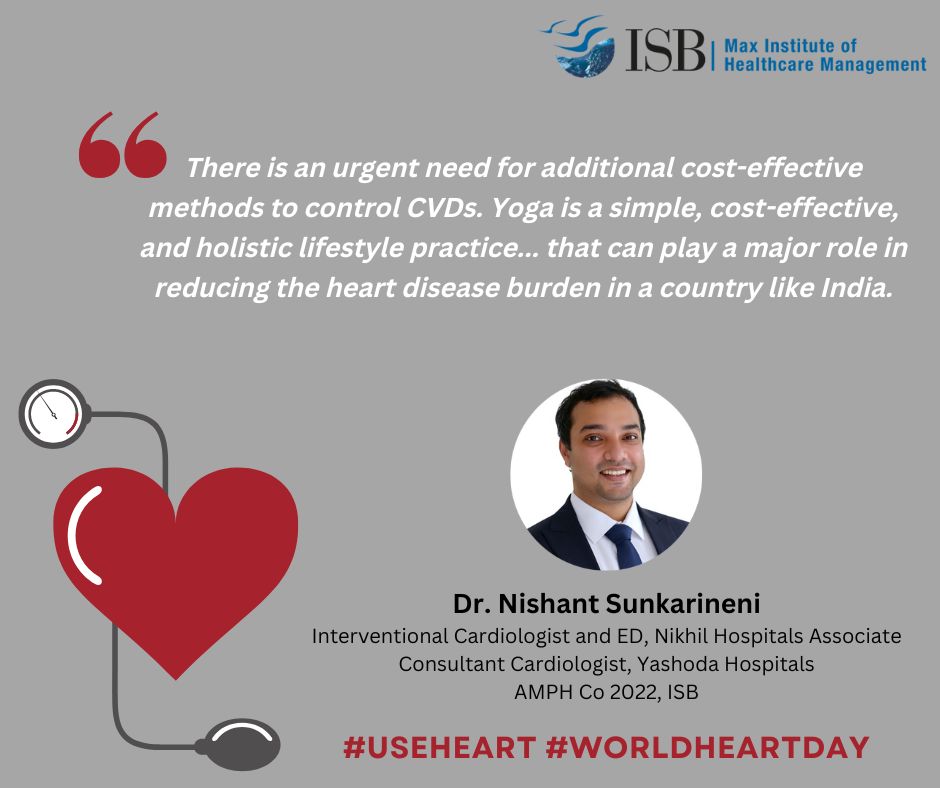
“The heart is the only organ you can hear and feel. It is the first and last sign of life. It is one of the few things with the potential to unite all of us as people” – World Heart Federation
World Heart Day – an international campaign curated by the World Heart Foundation to raise awareness and help battle cardiovascular disease (CVDs) – is aimed at engaging individuals, families, communities, institutions and governments around the world to create awareness and prevent CVD deaths due to modifiable risk factors such as physical inactivity, dietary factors, psychosocial stress and tobacco usage. The current CVD burden on the world population is extremely high, killing 17.5 million people every year. This makes CVDs the number one cause of death globally among non-communicable diseases (NCDs).
Another alarming reality is that CVD mortality rates are disproportionately increasing in low- and middle-income countries (LMICs) like India as opposed to high-income countries (HICs) where the CVD burden is on the decline. CVDs affect working-age populations much more and cause significant economic loss. Despite several advances in the medical field, there is a need for simple cost-effective techniques to prevent CVDs in a country like India.
This year, the World Heart Day focuses on the campaign “Use heart for every heart”. #UseHeart centres around humanity thinking differently to “make right decisions, to act with courage, and to help others”. The three pillars of “For every heart” are “Use ♥ for Humanity”, “Use ♥ for Nature”, and “Use ♥ for You”.
“Use ♥ for You” focuses on aspects like psychological stress which can double the risk of having a heart attack and emphasises the need for preventive actions like exercise, meditation and getting enough quality sleep to lower stress levels. Further the positive impact of mind-body practices like yoga and meditation improve the relationship between mind, brain, body, and behaviour and impact mental health thereby also impacting the physical health. Though there are several mind-body techniques such as Tai-Chi, visual imagery, hypnosis, and yoga, yoga appears to be the most studied as a low-cost and safe technique in a country like India.
Commonly-practiced yoga comprises (a) Stretching exercises (asanas), (b) Breathing techniques (pranayamas), and (c) Meditation. It is reported that practicing yoga can help control major risk factors for coronary artery diseases including hypertension, Diabetes Mellitus, obesity, dyslipidemia, psychological stress, and also help in smoking cessation.
- Yoga for hypertension: Yoga can help in reducing Systolic BP by 5-10 mm Hg and Diastolic BP by 3-5 mm Hg which could significantly reduce the risk of coronary artery disease mortality by more than 5%. A scientific statement by American Heart Association has stated that meditation also causes a modest decrease in BP and is recommended for all individuals with BP>120/80 mm Hg.
- Yoga for Type-2 Diabetes Mellitus: New onset DM can be prevented by 47% with yoga. Even in diabetics, yoga can help control blood sugar with values returning to normal in around 52% patients. Yoga helps in controlling insulin resistance, body mass index, waist circumference, and eventually improves the overall quality of life.
- Yoga for cholesterol: Several clinical trials indicated improvement in cholesterol levels by the practice of yoga within as early as 6 weeks.
- Yoga for smoking cessation: Brief training in mindfulness meditation can curb cravings in smokers and can reduce smoking by 60% as per a clinical trial. These changes were probably related to improved willpower and it has been suggested that yoga appears to be a promising technique as a complementary therapy for smoking cessation.
- Yoga for psychological stress: Psychological stress (depression and anxiety) has emerged as a significant risk factor for heart diseases and the risk of cardiac events. Stress is almost equivalent to smoking but can be reduced significantly with regular yoga and meditation.
Though a majority of risk factors for heart diseases and deaths occur in LMICs, the current preventive strategies have not been able to check the rising burden of these diseases. There is an urgent need for additional cost-effective methods to control CVDs. Yoga is a simple, cost-effective, and holistic lifestyle practice which can be recommended for both primary and secondary prevention of cardiac diseases and can play a major role in reducing the heart disease burden in a country like India.
This article is authored by Dr. Nishant Sunkarineni, Interventional Cardiologist and Executive Director, Nikhil Hospitals; Associate Consultant Cardiologist, Yashoda Hospitals; and AMPH Co 2022 student at the Indian School of Business.

